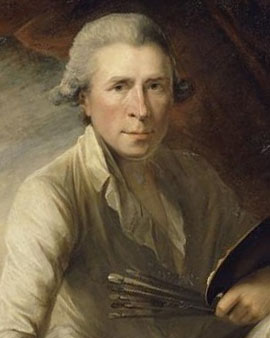George Romney was born on 15 December 1734 in Dalton-in-Furness, Lancashire, the son of the cabinetmaker John Romney. He died on 15 November 1802 in Kendal, Westmorland.
At the end of the 18th century, Romney is considered a modern portrait painter; he had acquired a particularly high reputation within British society. In his works, the artist avoided delving into the characters of his models. This dispassionate flattery was the cornerstone of his particular success among his patrons in the upper class.
The line dominated the colourful in his depictions, with the light poses and flowing transitions underlining the smooth pattern of his compositions.
After first training steps in his father's workshop he became a student of the genre painter Christopher Steele. Following various trips to the northern counties of Great Britain, his career began with his first portraits.
In 1762, the painter went to London. Here he first gained success at the British Society of Arts with his painting "The Death of General Wolfe", afterwards he devoted himself almost exclusively to portrait painting.
In 1764 George Romney travelled to Paris, where he became friends with the painter Joseph Vernet. On the other hand, Romney particularly admired the works of Nicolas Le Sueur, inspired by antiquity.
Further studies led Romney to Italy in 1773 to study the works of Raffael and Tizian - afterwards his paintings were considered more mature, as evidenced by the grace and elegance of portraits such as "Mrs. Carwardine and Son"(1775) and "Sir Christopher and Lady Sykes"(1786).
George Romney was considered sensitive and introverted by nature. He stayed away from the Royal Academy and his colleagues, but instead made friends in intellectual literary and philosophical circles. Around 1781-1782 Romney met the lady Emma Hart, later to become Lady Hamilton. He was so fascinated by her that she became his muse and the means of his escape into an imaginary world full of idealism.
Romney portrayed his "divine Emma" more than 50 times, and the paintings create numerous associations ranging from the combative Joan of Arc to the vinous Bacchante.
×





.jpg)
.jpg)
.jpg)
.jpg)
.jpg)
.jpg)
.jpg)
.jpg)
.jpg)
.jpg)
.jpg)
.jpg)
.jpg)
.jpg)
.jpg)
.jpg)
.jpg)
.jpg)
_-_(MeisterDrucke-1172527).jpg)
_-_(MeisterDrucke-1172527).jpg)
.jpg)
.jpg)
.jpg)
.jpg)
.jpg)
.jpg)
.jpg)
.jpg)
.jpg)
.jpg)
.jpg)
.jpg)
.jpg)
.jpg)
.jpg)
.jpg)
.jpg)
.jpg)
.jpg)
.jpg)
.jpg)
.jpg)
.jpg)
.jpg)
 - (MeisterDrucke-10639).jpg)
 - (MeisterDrucke-10639).jpg)
_-_(MeisterDrucke-1508379).jpg)
_-_(MeisterDrucke-1508379).jpg)
.jpg)
.jpg)
.jpg)
.jpg)
 - (MeisterDrucke-95217).jpg)
 - (MeisterDrucke-95217).jpg)
.jpg)
.jpg)
.jpg)
.jpg)
.jpg)
.jpg)
.jpg)
.jpg)
.jpg)
.jpg)
.jpg)
.jpg)
.jpg)
.jpg)
.jpg)
.jpg)
.jpg)
.jpg)
.jpg)
.jpg)
.jpg)
.jpg)
.jpg)
.jpg)
.jpg)
.jpg)
.jpg)
.jpg)
.jpg)
.jpg)
.jpg)
.jpg)
.jpg)
.jpg)
.jpg)
.jpg)
.jpg)
.jpg)
.jpg)
.jpg)
.jpg)
.jpg)
.jpg)
.jpg)
.jpg)
.jpg)
.jpg)
.jpg)
.jpg)
.jpg)
.jpg)
.jpg)
.jpg)
.jpg)
.jpg)
.jpg)
.jpg)
.jpg)
.jpg)
.jpg)
.jpg)
.jpg)
.jpg)
.jpg)
.jpg)
.jpg)
.jpg)
.jpg)
.jpg)
.jpg)
.jpg)
.jpg)
.jpg)
.jpg)
.jpg)
.jpg)
.jpg)
.jpg)
 - (MeisterDrucke-606165).jpg)
 - (MeisterDrucke-606165).jpg)
.jpg)
.jpg)
.jpg)
.jpg)
.jpg)
.jpg)
.jpg)
.jpg)
.jpg)
.jpg)
.jpg)
.jpg)
.jpg)
.jpg)
.jpg)
.jpg)
.jpg)
.jpg)
.jpg)
.jpg)
.jpg)
.jpg)
.jpg)
.jpg)
_-_(MeisterDrucke-294425).jpg)
_-_(MeisterDrucke-294425).jpg)
.jpg)
.jpg)
.jpg)
.jpg)
 - (MeisterDrucke-10929).jpg)
 - (MeisterDrucke-10929).jpg)
.jpg)
.jpg)
.jpg)
.jpg)
.jpg)
.jpg)
_-_(MeisterDrucke-903628).jpg)
_-_(MeisterDrucke-903628).jpg)
.jpg)
.jpg)
.jpg)
.jpg)
.jpg)
.jpg)
.jpg)
.jpg)
.jpg)
.jpg)
.jpg)
.jpg)
.jpg)
.jpg)
.jpg)
.jpg)
.jpg)
.jpg)
.jpg)
.jpg)
.jpg)
.jpg)
.jpg)
.jpg)
.jpg)
.jpg)






